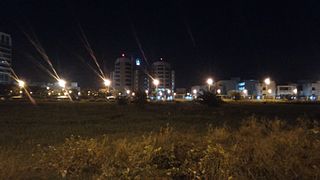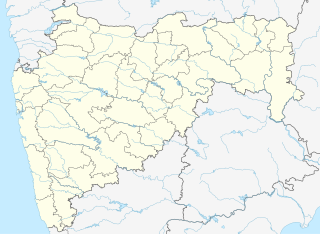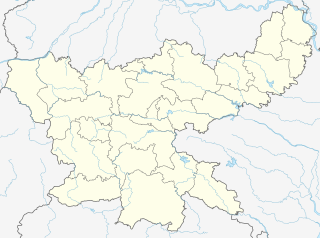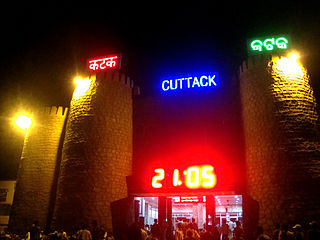
Coal mining is the process of extracting coal from the ground. Coal is valued for its energy content and since the 1880s has been widely used to generate electricity. Steel and cement industries use coal as a fuel for extraction of iron from iron ore and for cement production. In the United Kingdom and South Africa, a coal mine and its structures are a colliery, a coal mine is called a 'pit', and the above-ground structures are a 'pit head'. In Australia, "colliery" generally refers to an underground coal mine.

India is the world's third largest producer and third largest consumer of electricity. The national electric grid in India has an installed capacity of 383.37 GW as of 31 May 2021. Renewable power plants, which also include large hydroelectric plants, constitute 37% of India's total installed capacity. During the fiscal year (FY) 2019-20, the gross electricity generated by utilities in India was 1,383.5 TWh and the total electricity generation in the country was 1,598 TWh. The gross electricity consumption in FY2019 was 1,208 kWh per capita. In FY2015, electric energy consumption in agriculture was recorded as being the highest (17.89%) worldwide. The per capita electricity consumption is low compared to most other countries despite India having a low electricity tariff.

Jindal Steel and Power Limited (JSPL) is an Indian steel and energy company based in New Delhi, India. With turnover of approx. ₹40000 crore, JSPL is a part of about ₹130000 crore diversified Jindal Group conglomerate. JSPL is a leading player in steel, power, mining, oil and gas and infrastructure in India. The company produces steel and power through backward integration from its own captive coal and iron-ore mines.
The energy policy of India is largely defined by the country's expanding energy deficit and increased focus on developing alternative sources of energy, particularly nuclear, solar and wind energy. India attained 63% overall energy self-sufficiency in 2017.

The Ministry of Coal is an Indian government ministry headquartered in New Delhi. The portfolio is held by Cabinet Minister Pralhad Joshi.
Peak coal is the peak consumption or production of coal by a human community. Global coal consumption peaked in 2013, and had dropped slightly by the end of the 2010s. The peak of coal's share in the global energy mix was in 2008, when coal accounted for 30% of global energy production. The decline in coal use is largely driven by consumption declines in the United States and Europe, as well as developed economies in Asia. In 2019 production increases in countries; such as China, Indonesia, India, Russia and Australia; equalled the falls in the United States and Europe, but coal's structural decline continued in the 2020s.
Coal in India has been mined since 1774 and is now the second fastest mined in the world, producing 716 million metric tons in 2018. In 2017, India had 315.14 billion metric tons of coal. The estimated total reserves of lignite coal that month was 44.70 billion metric tons. Due to high demand and poor average quality, India imports coking coal to meet the requirements of its steel plants. India's coal imports have risen from 49.8 million metric tons in 2007–08 to 191 million metric tons in 2016–17. India's coal exports rose from 1.63 million metric tons in 2007–08 to 2.44 million metric tons in 2012–13, but subsequently declined to 1.77 million metric tons in 2016–17. Dhanbad city is the largest coal producing city and is called the Coal Capital of India. State-owned Coal India had a monopoly on coal mining between its nationalisation in 1973 and 2018.
Resources are classified as either biotic or abiotic on the basis of their origin. The Indian landmass contains a multitude of both types of resources and its economy, especially in rural areas, is heavily dependent on their consumption or export. Due to overconsumption, they are rapidly being depleted.
The Dęby Szlacheckie coal mine is a large mine in the north of Poland in Dęby Szlacheckie, Greater Poland Voivodeship, 130 km north-west of the capital, Warsaw. Dęby Szlacheckie represents one of the largest coal reserves in Poland having estimated reserves of 92 million tonnes of coal. Annual coal production is around 3.3 million tonnes.

NTPC Limited, formerly known as National Thermal Power Corporation Limited, is an Indian government electricity board engaged in the business of generation of electricity and allied activities. It is a company incorporated under the Companies Act 1956 and is under the ownership of Ministry of Power, Government of India. The headquarters of the company is situated at New Delhi. NTPC's core business is the generation and sale of electricity to state-owned power distribution companies and State Electricity Boards in INDIA. The company also undertakes consultancy and turnkey project contracts that involve engineering, project management, construction management, and operation and management of power plants.
South Eastern Coalfields Limited (SECL) is the largest coal producing company of India. It is a "Miniratna" Company, and one of eight fully owned subsidiaries of Coal India Limited. The company has its headquarter at Bilaspur, Chhattisgarh, India and 92 mines spread over Chhattisgarh & Madhya Pradesh; 70 underground, 21 opencast, and 1 mixed. It is a schedule 'B' Mini Ratna CPSE in coal & lignite under the administrative control of Ministry of Coal
Eastern Coalfields Limited (ECL) is a coal producer based in India. The company was founded in 1975 after nationalisation of coal mines in India. It operates coal mines in Jharkhand and West Bengal states of India. It inherited all the private sector coal mines of the Raniganj Coalfield. It is one of the fully owned subsidiaries of Coal India Limited. The company has its headquarters at Sanctoria, in West Bengal.

Kamptee Coalfield is located in Nagpur district in the Vidarbha region of the Indian state of Maharashtra.

Godavari Valley Coalfield is located in the districts of Adilabad, Karimnagar, Khammam and Warangal in the Indian state of Telangana. It is the only coalfield in South India. It lies in the basin of the Godavari River.
The Birbhum is a large coal field located in the east of India in West Bengal. Birbhum is having estimated reserves of 5 billion tonnes of coal.

The Rajmahal Coalfield is a large coal field located in the east of India in Jharkhand.

Balrampur-Ramanujganj district is a district in the Indian state of Chhattisgarh. It came into existence on 17 January 2012 and was formerly part of Surguja district. Balrampur-Ramanujganj district is the northernmost district of Chhattisgarh. It's seat is Balrampur.

Giridih Coalfield is located in Giridih district in the Indian state of Jharkhand.

The Cuttack–Sambalpur line is a railway line connecting the cities of Cuttack with the Sambalpur, in the Indian state of Odisha.

Hasdeo Arand is a forest in the Indian state of Chhattisgarh, located in the centre-east of the country. It is on top of the Hasdeo coalfield in the east of India in Chhattisgarh. The government of India has proposed to mine the coal, which would destroy the forest.










